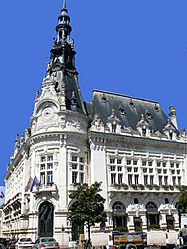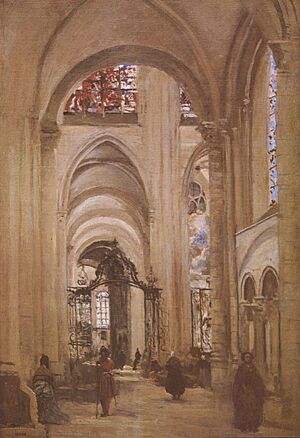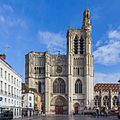Sens facts for kids
Quick facts for kids
Sens
|
||
|---|---|---|

City Hall of Sens
|
||
|
||
| Country | France | |
| Region | Bourgogne-Franche-Comté | |
| Department | Yonne | |
| Arrondissement | Sens | |
| Area
1
|
27.86 km2 (10.76 sq mi) | |
| Population
(2006)
|
26,646 | |
| • Density | 956.42/km2 (2,477.1/sq mi) | |
| Time zone | UTC+01:00 (CET) | |
| • Summer (DST) | UTC+02:00 (CEST) | |
| INSEE/Postal code |
89387 /89100
|
|
| 1 French Land Register data, which excludes lakes, ponds, glaciers > 1 km2 (0.386 sq mi or 247 acres) and river estuaries. | ||

Sens is a city in north-central France. It is located in the Yonne area of the Bourgogne-Franche-Comté region. Sens is about 120 kilometers (75 miles) away from Paris.
This city is an important center in its department. It is the second largest city in Yonne and the sixth largest in its region. The Yonne River flows through Sens. The Vanne River also joins the Yonne here.
Contents
The Story of Sens
Sens has a very long history. It was once a major town for the Senones, an ancient Celtic tribe. These tribes lived in Gaul, which is what France was called long ago.
Sens in Roman Times
The Roman general Julius Caesar wrote about Sens. He called it Agedincum in his famous book, Commentarii de Bello Gallico. This book was about his wars in Gaul.
The Romans built a city here in the first century BC. They later added strong walls around it in the third century. Even today, you can still see the basic layout of the old Roman streets in Sens.
Later, a writer named Ammianus Marcellinus mentioned Sens. He called it Senones. The future Roman emperor Julian once faced a siege here. This happened when the Alamanni tribe attacked the city for several months. Sens became an important administrative center around the year 375. It was the main town of a Roman province called Lugdunensis Quarta.
The Middle Ages and Beyond
During the Middle Ages, the archbishops of Sens were very powerful. An archbishop is a very high-ranking church leader. They were known as the "primate of Gaul and Germany." This meant they had a lot of authority over other church leaders.
The Hôtel de Sens in Paris was their official home in that city. The Archdiocese of Sens was in charge of many other church areas. These included Chartres, Auxerre, Meaux, Paris, Orléans, Nevers, and Troyes.
The Famous Cathedral
Work on the cathedral of Sens began in 1135. It is dedicated to Saint Stephen. This cathedral was one of the very first buildings made in the Gothic style. This style is known for its tall arches and large stained-glass windows.
Many important events happened at the cathedral:
- In 1234, Louis IX of France got married there. He was a king of France.
- The famous scholar Peter Abelard had a trial in Sens.
- Pope Alexander III, the head of the Catholic Church, stayed in Sens for some time.
- Thomas Becket, an important English archbishop, lived in Sens for part of his exile. This was between 1162 and 1165.
- The Archdiocese of Sens also hosted several important church meetings.
- The first Archbishop of Uppsala in Sweden was consecrated, or officially made, an archbishop here.
- William of Sens, an architect from Sens, was a main builder of Canterbury Cathedral in England.
Sens faced difficult times during the French Wars of Religion. These were a series of conflicts in France.
The city's importance decreased after Paris became an archdiocese in 1622. Today, Sens is still an archbishopric. However, the main archbishop lives in Auxerre.
Sens remains connected to Paris for legal matters. It is still part of the Paris cour d'appel, which is a type of court.
Images for kids
See also
 In Spanish: Sens (Yonne) para niños
In Spanish: Sens (Yonne) para niños



